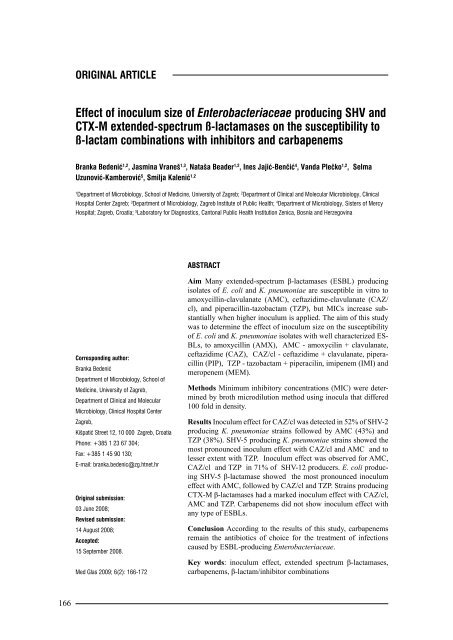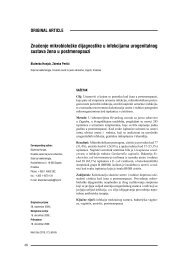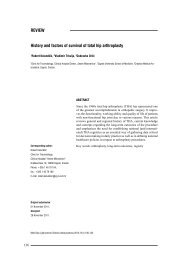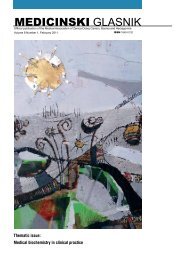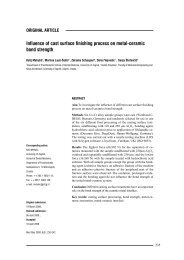MEDICINSKI GLASNIK
MEDICINSKI GLASNIK
MEDICINSKI GLASNIK
Create successful ePaper yourself
Turn your PDF publications into a flip-book with our unique Google optimized e-Paper software.
166<br />
ORIGINAL ARTICLE<br />
Effect of inoculum size of Enterobacteriaceae producing SHV and<br />
CTX-M extended-spectrum ß-lactamases on the susceptibility to<br />
ß-lactam combinations with inhibitors and carbapenems<br />
Branka Bedenić 1,2 , Jasmina Vraneš 1,3 , Nataša Beader 1,2 , Ines Jajić-Benčić 4 , Vanda Plečko 1,2 , Selma<br />
Uzunović-Kamberović 5 , Smilja Kalenić 1,2<br />
1 2 Department of Microbiology, School of Medicine, University of Zagreb; Department of Clinical and Molecular Microbiology, Clinical<br />
Hospital Center Zagreb; 3Department of Microbiology, Zagreb Institute of Public Health; 4Department of Microbiology, Sisters of Mercy<br />
Hospital; Zagreb, Croatia; 5Laboratory for Diagnostics, Cantonal Public Health Institution Zenica, Bosnia and Herzegovina<br />
Corresponding author:<br />
Branka Bedenić<br />
Department of Microbiology, School of<br />
Medicine, University of Zagreb,<br />
Department of Clinical and Molecular<br />
Microbiology, Clinical Hospital Center<br />
Zagreb,<br />
Kišpatić Street 12, 10 000 Zagreb, Croatia<br />
Phone: +385 1 23 67 304;<br />
Fax: +385 1 45 90 130;<br />
E-mail: branka.bedenic@zg.htnet.hr<br />
Original submission:<br />
03 June 2008;<br />
Revised submission:<br />
14 August 2008;<br />
Accepted:<br />
15 September 2008.<br />
Med Glas 2009; 6(2): 166-172<br />
ABSTRACT<br />
Aim Many extended-spectrum β-lactamases (ESBL) producing<br />
isolates of E. coli and K. pneumoniae are susceptible in vitro to<br />
amoxycillin-clavulanate (AMC), ceftazidime-clavulanate (CAZ/<br />
cl), and piperacillin-tazobactam (TZP), but MICs increase substantially<br />
when higher inoculum is applied. The aim of this study<br />
was to determine the effect of inoculum size on the susceptibility<br />
of E. coli and K. pneumoniae isolates with well characterized ES-<br />
BLs, to amoxycillin (AMX), AMC - amoxycilin + clavulanate,<br />
ceftazidime (CAZ), CAZ/cl - ceftazidime + clavulanate, piperacillin<br />
(PIP), TZP - tazobactam + piperacilin, imipenem (IMI) and<br />
meropenem (MEM).<br />
Methods Minimum inhibitory concentrations (MIC) were determined<br />
by broth microdilution method using inocula that differed<br />
100 fold in density.<br />
Results Inoculum effect for CAZ/cl was detected in 52% of SHV-2<br />
producing K. pneumoniae strains followed by AMC (43%) and<br />
TZP (38%). SHV-5 producing K. pneumoniae strains showed the<br />
most pronounced inoculum effect with CAZ/cl and AMC and to<br />
lesser extent with TZP. Inoculum effect was observed for AMC,<br />
CAZ/cl and TZP in 71% of SHV-12 producers. E. coli producing<br />
SHV-5 β-lactamase showed the most pronounced inoculum<br />
effect with AMC, followed by CAZ/cl and TZP. Strains producing<br />
CTX-M β-lactamases had a marked inoculum effect with CAZ/cl,<br />
AMC and TZP. Carbapenems did not show inoculum effect with<br />
any type of ESBLs.<br />
Conclusion According to the results of this study, carbapenems<br />
remain the antibiotics of choice for the treatment of infections<br />
caused by ESBL-producing Enterobacteriaceae.<br />
Key words: inoculum effect, extended spectrum β-lactamases,<br />
carbapenems, β-lactam/inhibitor combinations


